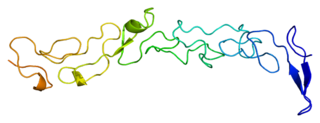
Tenascins are extracellular matrix glycoproteins. They are abundant in the extracellular matrix of developing vertebrate embryos and they reappear around healing wounds and in the stroma of some tumors.

Tenascins are extracellular matrix glycoproteins. They are abundant in the extracellular matrix of developing vertebrate embryos and they reappear around healing wounds and in the stroma of some tumors.
There are four members of the tenascin gene family: tenascin-C, tenascin-R, tenascin-X and tenascin-W.
The basic structure is 14 EGF-like repeats towards the N-terminal end, and 8 or more fibronectin-III domains which vary upon species and variant.
Tenascin-C is the most intensely studied member of the family. It has anti-adhesive properties, causing cells in tissue culture to become rounded after it is added to the medium. One mechanism to explain this may come from its ability to bind to the extracellular matrix glycoprotein fibronectin and block fibronectin's interactions with specific syndecans. The expression of tenascin-C in the stroma of certain tumors is associated with a poor prognosis.

Fibronectin is a high-molecular weight glycoprotein of the extracellular matrix that binds to membrane-spanning receptor proteins called integrins. Fibronectin also binds to other extracellular matrix proteins such as collagen, fibrin, and heparan sulfate proteoglycans.

In biology, the extracellular matrix (ECM), also called intercellular matrix (ICM), is a network consisting of extracellular macromolecules and minerals, such as collagen, enzymes, glycoproteins and hydroxyapatite that provide structural and biochemical support to surrounding cells. Because multicellularity evolved independently in different multicellular lineages, the composition of ECM varies between multicellular structures; however, cell adhesion, cell-to-cell communication and differentiation are common functions of the ECM.

A disintegrin and metalloproteinase with thrombospondin motifs 2 (ADAM-TS2) also known as procollagen I N-proteinase is an enzyme that in humans is encoded by the ADAMTS2 gene.

Versican is a large extracellular matrix proteoglycan that is present in a variety of human tissues. It is encoded by the VCAN gene.
Teneurins are a family of phylogenetically conserved single-pass transmembrane glycoproteins expressed during pattern formation and morphogenesis. The name refers to "ten-a" and "neurons", the primary site of teneurin expression. Ten-m refers to tenascin-like protein major.

Tenascin X (TN-X), also known as flexillin or hexabrachion-like protein, is a 450kDa glycoprotein, a member of the tenascin family, that is expressed in connective tissues. In humans it is encoded by the TNXB gene.

Collagen alpha-1(V) chain is a protein that in humans is encoded by the COL5A1 gene.

Matrilysin also known as matrix metalloproteinase-7 (MMP-7), pump-1 protease (PUMP-1), or uterine metalloproteinase is an enzyme in humans that is encoded by the MMP7 gene. The enzyme has also been known as matrin, putative metalloproteinase-1, matrix metalloproteinase pump 1, PUMP-1 proteinase, PUMP, metalloproteinase pump-1, putative metalloproteinase, MMP). Human MMP-7 has a molecular weight around 30 kDa.

Tenascin C (TN-C) is a glycoprotein that in humans is encoded by the TNC gene. It is expressed in the extracellular matrix of various tissues during development, disease or injury, and in restricted neurogenic areas of the central nervous system. Tenascin-C is the founding member of the tenascin protein family. In the embryo it is made by migrating cells like the neural crest; it is also abundant in developing tendons, bone and cartilage.

Laminin subunit gamma-2 is a protein that in humans is encoded by the LAMC2 gene.

Laminin subunit alpha-3 is a protein that in humans is encoded by the LAMA3 gene.

Laminin subunit gamma-1 is a protein that in humans is encoded by the LAMC1 gene.

Fibulin-2 is a protein that in humans is encoded by the FBLN2 gene.

Collagen alpha-1(XIV) chain is a protein that in humans is encoded by the COL14A1 gene. It likely plays a role in collagen binding and cell-cell adhesion.

Integrin alpha-9 is a protein that in humans is encoded by the ITGA9 gene. Cytogenetic location: 3p22.2

Integrin alpha-8 is a protein that in humans is encoded by the ITGA8 gene.

In medicine, desmoplasia is the growth of fibrous connective tissue. It is also called a desmoplastic reaction to emphasize that it is secondary to an insult. Desmoplasia may occur around a neoplasm, causing dense fibrosis around the tumor, or scar tissue (adhesions) within the abdomen after abdominal surgery.

Teneurin-3, also known as Ten-m3, Odz3, Ten-m/Odz3, Tenascin-like molecule major 3 or Teneurin transmembrane protein 3, is a protein that, in humans, is encoded by the TENM3, or ODZ3, gene. Ten-m3 is a ~300 kDa type II transmembrane glycoprotein that is a member of the teneurin/Ten-m/Odz family. The teneurin family currently consists of four members: Ten-m1-Ten-m4. Ten-ms are conserved across both vertebrate and invertebrate species. They are expressed in distinct, but often interconnected, areas of the developing nervous system and in some non-neural tissues. Like the Ten-m family, Ten-m3 plays a critical role in regulating connectivity of the nervous system, particularly in axon pathfinding and synaptic organisation in the motor and visual system. Mutation in the TENM3/ODZ3 gene in humans has been associated with the eye condition, microphthalmia.
Ruth Chiquet-Ehrismann was a Swiss biochemist and cell biologist working on interactions in the extracellular matrix.
RCCX is a complex, multiallelic, and tandem copy number variation (CNV) human DNA locus on chromosome 6p21.3, a cluster located in the major histocompatibility complex (MHC) class III region. CNVs are segments of DNA that vary in copy number compared to a reference genome and play a significant role in human phenotypic variation and disease development. The RCCX cluster consists of one or more modules each having a series of genes close to each other: serine/threonine kinase 19 (STK19), complement 4 (C4), steroid 21-hydroxylase (CYP21), and tenascin-X (TNX).